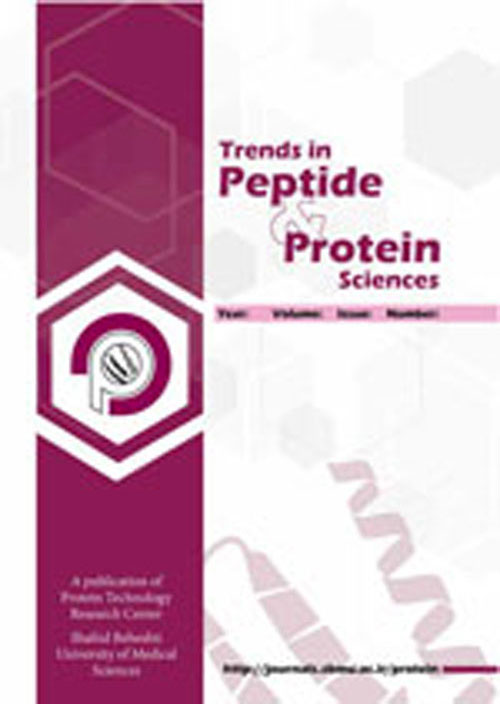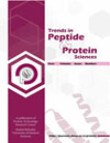فهرست مطالب

Trends in Peptide and Protein Sciences
Volume:6 Issue: 1, Jan 2021
- تاریخ انتشار: 1400/06/13
- تعداد عناوین: 7
-
-
Page 1
Pectinase or pectinolyticenzyme is a complex enzyme with different catalytic units including polygalacturonase, pectin esterase and pectin lyase to degrade pectin polymers into different end products. The pectinase with degrading capability of pectin can be utilized in various industrial applications, such as clarification of fruits and vegetable juices, degumming of plant bast fibers, textile industries for removing non-cellulosic impurities, papermaking industries, wine clarification, coffee and tea fermentation, wastewater treatment, as well as, it is also used for the isolation of protoplasm in plant science research. Pectin derived oligosaccharides (POS) produced by pectinase are considered as prebiotic molecules. However, the low operational stability in harsh industrial conditions confines the utilization of pectinase in industrial processes. Immobilization is the technique, which not only enhanced the stability of pectinase, but also, made the enzyme reusable for continuous industrial processes. The current review shares information about the pectinase and how the immobilization technology can enhance the industrial application of pectinase. Furthermore, various supports such as sodium alginate, agar-agar, polyacrylamide, aminated silica gel, nanocomposite microspheres, silica coated chitosan, nylon-6, porous glass etc. have been tested for the immobilization of pectinase through different methods, including entrapment, binding to a support and enzyme crosslinking.
Keywords: Degradation, Enzyme, Immobilization, Pectin, Pectinase -
Page 2
Sickle cell diseases are the most prevalent monogenic blood diseases with complications such as severe end-organ harm, pain, and reduced life expectancy. Dealing options for sickle cell diseases are inadequate, as there are just two FDA-approved drugs to decrease acute manifestation. The only sickle cell diseases curative procedure is bone marrow transplantation, frequently from a harmonized, related donor. Ex vivomanipulation of autologous hematopoietic stem and progenitor cells and subsequent transplantation of genetically altered cells theoretically offer an everlasting therapy appropriate to all sickle cell anemia patients, regardless of the accessibility of fit donors and graft-versus-host disease. In this review, we emphasize applying CRISPR gene editing strategies for sickle cell anemia treatment, containing the genetic modification and rectification of sickle cell disease mutation in β-globin and the stimulation of fetal hemoglobin to protect cells against sickling. We summarize the importance of stem cell manipulation to cure sickle cell anemia having likely lifetimeefficacy for cell and gene therapies.
Keywords: CRISPR, Cas, Irregular hemoglobin S, Fatal hemoglobin, Gene editing, Sickle cell disease -
Page 3
Early detection of thrombus and its location in the body are critical factors for the treatment of thrombosis related diseases. Fibrin is the main component of thrombus, abundant in all thrombi, and is not found in non-pathological conditions. The presenceof fibrin in all types of thrombi and its low concentration in blood makes it a sensitive and specific target for imaging studies of thrombus. Fibrin also accumulates in malignant tumors. Thus, fibrin imaging can be used in oncology, atherosclerosis, and thrombosis-related pathologies such as pulmonary emboli and deep vein thrombosis. Different compounds such as antibodies, nanoparticles, and peptides have been studied for fibrin imaging. Among them, peptides are more attractive because of better pharmacokinetics, simple and cheap preparation, and better radiolabeling methods. In this study, two peptides (HYNIC-GPRPILE, HYNIC-GPKGAAD) designed to target fibrin were synthesized. The peptides were identified by LC-MS. The stability and platelet aggregation of peptides were determined. Peptides were radiolabeled with 99mTc using HYNIC as chelating agent. The release of 99mTc and fibrin binding of radiopeptideswere evaluated. Based on the results, peptides were stable in human plasma for at least 6 h and had no effect on platelet aggregation. Peptides were radiolabeled with pertechnetate at 80°C in 30 min. Radiochemical purity was over 95%. Radiopeptides were stable in human plasma and there was less than 5% release of 99mTc. The fibrin binding of radiopeptides was 70%>. Since peptides had no platelet binding activity, it can be concluded that binding of radiopeptides to fibrin is specific.
Keywords: Fibrin, HYNIC, Peptide, Thrombus, 99mTcEarly -
Page 4
A well-designed vaccine against Streptococcus pneumonia, a respiratory pathogen, by immunoinformaticsapproaches can lead to an effective mucosal and local immunity in the upper respiratory tract. In this study, we chose virulence proteins from different strains of S. pneumonia(Pneumolysin, Neuraminidase, Zink-Metalloproteinase, and Hydrolase) and designed a new multi-epitope construct by properly linking the individual predicted T and B cell specific epitopes. Then, the polytope, named PNEU, was expressed in Escherichia colias a prokaryotic system. Through computational calculations, PNEU polypeptide with 216 aa has the theoretical pI 8.04 and instability index 33.63, which show that it is a stable and soluble protein. Also, the 3D structure of PNEU was predicted by Phyre2 server with 96.0% confidence.In conclusion, PNEU protein can be considered as a stable and soluble immunogenic protein, which may be efficiently used for immunity stimulation in laboratory animals, investigated in future studies.
Keywords: Immunoinformatics, In silicodesign, Poly-epitope, Streptococcus, pneumoniae, Subunit vaccine -
Page 5
One of the common studies on industrial proteins is to study the RNA Folding and stability, protein stability, physicochemical properties and conformational structure. In our previous proteomics study, Metallopeptidase (MP) was isolated from Lactobacilluscasei,which in this study, it was evaluated with RNA fold, Protparam, I-TASSER and Phyre2 web servers. The results showed that it fairly has a suitable RNA folding in terms of minimum energy. In addition, Phyre2 could model the protein with 100% confidence and 68% coverage with human protease. Secondary structure of MP contains 45% alpha helix and 8% beta strand, 31% Disordered and 3% TM helix. The estimated TM-score for final predicted MP model was 0.38±0.13 and calculated RMSD was 15.9±3.2Aº. Phyre2 investigator showed thatR217, G63, K64, F27 and G58 in active site participate in the reaction with the substrate. In conclusion, predicted structure of bacterial metallopeptidase in acidic conditions has 68% coverage with human protease.
Keywords: 3D structure, Molecular modeling, Lactobacillus casei, Metallopeptidase, RNA folding -
Page 6
The distorted membrane asymmetry and abnormal distribution of phospholipids viz. phosphatidylserine (PS) and phosphatidylethanolamine (PE), in the outer leaflet are one of the critical features of cancer. It is a much-known fact that protein, such as spectrin (SPC), has an affinity towards the PS and PE. Hence, SPC was used to target exposed PS and PE of cancer cells. In the present study, the drug Methotrexate was used because it disrupts and fluidized the plasma membrane. Liposomes prepared and optimized by the Response Surface Box Behnken randomized model using various independent and dependent variables. The optimized liposomes were further coated with SPC and the coating confirmed by infrared spectroscopy. Both formulations were further characterized for vesicle size, entrapment efficiency (EE), zeta potential, surface morphology, and percentage of drug released. The results indicate that the prepared formulations were in spherical, nano-metric size with negative zeta potential and more than 75% drug entrapment with sustained release pattern. The concentration for 50% of maximal inhibition of cell proliferation (GI50) in U373-MG cells was found to be 24.11±0.44 and 3.90±0.19 µg/mL of the formulations MTX-LP2 and SPC-MTX-LP2, respectively. Briefly, results suggest that the developed liposomes could be used for enhanced cancer treatment.
Keywords: Design of Experiment, Liposomes, Phosphatidylserine, Phosphatidylethanolamine, Spectrin, T umor membrane targeting -
Page 7
The Trends in Peptide and Protein Sciences is a peer-reviewed, online-only (previously print-online), scientific journal owned by Protein Technology Research Center, Shahid Beheshti University of Medical Sciences and documents in all important aspects of the research in peptides and proteins focusing on analytics and impurities, bioinformatics, biopharmaceuticals and vaccines, biotechnology, chemical synthesis, conformational analysis, design and development of protein therapeutics, determination of structure, enzymology, folding and sequencing, formulation and stability, function, genetics, immunology, kinetics, modeling, molecular biology, pharmacokinetics and pharmacodynamics of therapeutic proteins and antibodies, pharmacology, protein engineering and development, protein-protein interaction, proteomics, purification/expression/production, simulation, thermodynamics and hydrodynamics and protein biomarkers. The aim of this Journal is to publish high quality original research articles, reviews, short communications and letters and to provide a medium for scientists and researchers to share their findings from the area of peptides and proteins. The Trends in Peptide and Protein Sciences is published in collaboration with Iranian Association of Pharmaceutical Scientists. From volume 3 (2018) of TPPS, articles are continuously published online only, as soon as the review process is completed.
Keywords: Author Package


